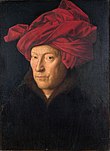
Portrait of a Man with Carnation is a small oil on oakwood painting usually attributed to the Early Netherlandish master Jan van Eyck or a member of his workshop. Based on dendrochronological examination of the wood, it is thought to have been completed relatively late in van Eycks career, perhaps around 1436.[1] It is now in the Gemäldegalerie, Berlin. The sitter wears a large grey fur lined hat, and grey clothes, fur lined at the neck. holds a small bunch of carnations, symbols of marriage. He has not been identified, but wears the medal of the Order of Saint Anthony, established by Albert I, Duke of Bavaria. The man is older, probably in his early 50s, and has a coarse, rough look.[2]
Notes
[edit]Sources
[edit]- Ammann, Ruth. In The Enchantment of Gardens: A Psychological Approach. Daimon Verlag, 2009. ISBN 3-8563-0724-9
- Giltay, J. Review of "Hubert and Jan van Eyck" by Elisabeth Dhanens. Simiolus: Netherlands Quarterly for the History of Art, Volume 13, No. 1, 1983
- Borchert, Till-Holger. Van Eyck. London: Taschen, 2008. ISBN 3-8228-5687-8

Well, that’s interesting to know that Psilotum nudum are known as whisk ferns. Psilotum nudum is the commoner species of the two. While the P. flaccidum is a rare species and is found in the tropical islands. Both the species are usually epiphytic in habit and grow upon tree ferns. These species may also be terrestrial and grow in humus or in the crevices of the rocks.
View the detailed Guide of Psilotum nudum: Detailed Study Of Psilotum Nudum (Whisk Fern), Classification, Anatomy, Reproduction